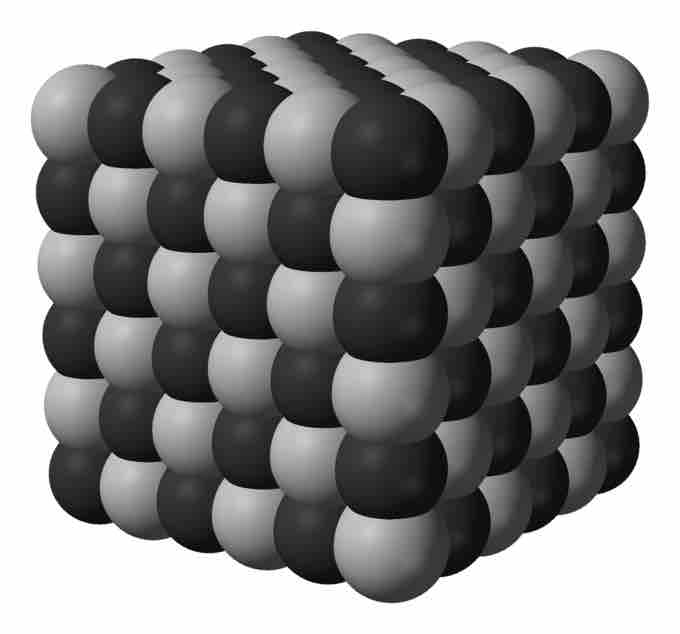Types of Carbides
Carbides are compounds composed of carbon and less electronegative elements and they are distinguished by their chemical bonding (ionic, covalent). They are generally prepared from metals or metal oxides at high temperatures (1500 °C or higher) by combining the metal with carbon. Carbides are used in key industrial applications.

Titanium Carbide
Lattice structure of titanium carbide.
Saline Carbides
Salt-like (saline) carbides are composed of the highly electropositive atoms, such as the alkali, alkali earth, and group-III metals, mixed with carbon. Aluminum forms carbides, but other elements from group XIII do not. These materials have isolated carbon centers, often described as "C4-" in the metanides, "C22-" in the acetylides, and "C34-" in the sesquicarbides.
- Methanides are carbides that decompose in water and generate water; aluminum carbide (Al4C3) and beryllium carbide (Be2C) are examples of this class of carbides.
- Acetylides are formed from alkali, alkali earth, and lanthanoid metals with the acetylide anion C22-. Lanthanoids also form carbides with the formula M2C3. Metals from group XI also form acetylides, such as copper(I) acetylide and silver acetylide. Carbides of the actinide elements, which have the structure MC2 and M2C3, are also described as salt-like derivatives of C22-.
- The polyatomic ion C34- is referred to as an allylenide or sesquicarbide and is found in Li4C3 and Mg2C3. The allylenide is linear and isoelectronic with CO2.
Covalent Carbides
Covalent carbides are found in carbides of silicon and boron. The reason these two elements form "covalent" carbides is due to their similar electronegativity and size to carbon. Because of this, their association is completely covalent in character. Silicon carbide has two similar crystalline forms, which are both related to the diamond structure. Boron carbide (B4C), on the other hand, has an unusual structure that includes icosahedral boron units linked by carbon atoms. In this respect, boron carbide is similar to the boron-rich borides. Both silicon carbide (also known as carborundum) and boron carbide are very hard and refractory materials. Both materials have important industrial applications.
Interstitial Carbides
Interstitial carbides describe the carbides of the group-IV, -V, and VI transition metals. These carbides are metallic and refractory. They are formed so that the carbon atoms fit into octahedral interstices in a close-packed metal lattice when the metal atom's radius is greater than ~135 pm. When the metal atoms are cubic-close-packed (ccp), then filling all of the octahedral interstices with carbon achieves 1:1 stoichiometry with the rock-salt structure. When the metal atoms are hexagonal-close-packed, (hcp), since the octahedral interstices lie directly opposite each other on either side of the layer of metal atoms, filling only one of these with carbon achieves 2:1 stoichiometry. As a result of the packing, they are quite stable and have very high melting points and low electrical resistance.
Intermediate Transition Metal Carbides
In intermediate transition metal carbides, the transition-metal ion is smaller than the critical 135 pm, and the structures are not interstitial but are more complex. Multiple stoichiometries are common. For example, iron forms a number of carbides: Fe3C, Fe7C3 and Fe2C. The best known is cementite, Fe3C, which is present in steels. These carbides are more reactive than the interstitial carbides; for example, the carbides of Cr, Mn, Fe, Co, and Ni are all hydrolyzed by dilute acids (and sometimes by water) to yield a mixture of hydrogen and hydrocarbons. These compounds share features with both the inert interstitials and the more reactive salt-like carbides.
Metal complexes containing Cn fragments are well known. These molecular carbides often have carbon-centered clusters. Some metals such as tin and lead are not believed to form carbides.